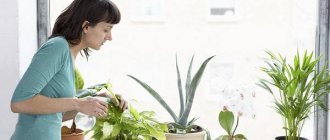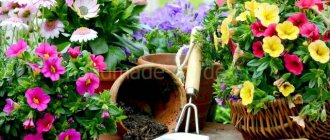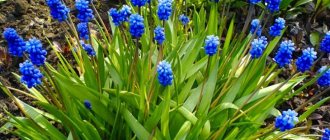The main problem of watering your house plants is to solve the following questions: how often should you water indoor flowers?, what kind of water should you water indoor flowers?, is it possible to water indoor flowers with beer?, what should you water indoor flowers with for rapid growth and abundant flowering?, can should indoor plants stay without watering for a while?, how to water indoor flowers correctly and is it possible to water indoor flowers with potassium permanganate?, what kind of water should there be for watering indoor plants?, is it possible to water indoor flowers with boiled water?, we will try to answer all these questions below. You need to water the flowers in such a way that your indoor plant receives a sufficient amount of water.
Moisture is involved in processes such as nutrition of roots, leaves and the entire plant as a whole. And most importantly, it takes an active part in photosynthesis. Through irrigation water, basic nutrients enter the soil by adding various mineral fertilizers to it.
If granular mineral fertilizers of prolonged action are used, interaction with liquid gradually contributes to their erosion and penetration into the soil. Liquid fertilizers added to water for irrigation mainly feed the roots, through which all the nutrients flow further to the plant. It is important to know how to properly water indoor plants.
Watering each plant is directly dependent on the place where it grows; in other words, it is necessary to ensure that watering occurs naturally in the homeland of each plant. When watering, you should also take into account the time of year, winter, spring or summer, autumn.
Each period of time requires its own watering regime. Consider lighting and temperatures at all times of the year. Of course, you need to understand the size and age of the flower, and how much moisture it needs. Of course, the peculiarity of the soil is its water permeability and ability to retain moisture.
Herbaceous plants, such as calathea, begonia, ferns, need more moisture, watering should be plentiful. Plants with succulent foliage and fleshy stems contain moisture reserves there, which means they are not so demanding when it comes to watering.
In winter, the need for watering is noticeably less.
Rare watering
Usually these are plants that grow in desert or semi-desert. The soil should dry out completely between waterings for such plants. This applies to all cacti, Crassula, Gavrotia, Sansevieria, as well as all bulbous and corm plants (gloxinia).
Determining the need for watering is quite simple. To do this, just look at the soil. Dry soil becomes lighter in color as it dries. It can be checked by touch. Or use special devices to measure soil moisture. There is also a method for determining the humidity in a pot with a plant. This is the weight of the pot and the sound the pot makes when you tap it.
In large pots or tubs, we determine the humidity not on the surface, but at a depth of 15 centimeters. This can be determined using measuring instruments or a stick. If there is still soil on the stick, then it is too early to water. Wait until the soil dries out a little more. In spring and summer, watering needs to be increased. And moisture-loving plants are watered twice a day (morning/evening).
How to determine that a flower needs to be watered?
You can understand that a plant is thirsty by external signs:
- leaves are drooping, soft, drooping;
- the crown looks dehydrated, but the stem is strong;
- the soil is light and extends away from the edges of the pot.
These signs indicate that the plant is a little dry. You shouldn’t let it get too dry, although plants perceive overdrying much easier than overwatering. The “golden mean” of drying will be the moment when the flowerpot is already light, but the soil inside is still slightly damp. You can determine the soil moisture with your finger or a wooden skewer. Often, plant manufacturers indicate watering requirements on the label, namely the frequency and type of moisture. The following marks can be found on the pot:
- abundant watering means that the soil must be constantly moist and even short-term drying out is unacceptable;
- moderate watering means that the contents of the pot should be allowed to dry out a couple of centimeters between waterings;
- Rare watering means that the soil in the pot needs to be completely dried.
Cacti, hippeastrum, philodendron, Kalanchoe, and epiphyllum require rare watering. Most other plants require moderate watering. You should switch to abundant watering only during the flowering period.
Proper watering
We bring the edge of the spout of the watering can to the edge of the soil, so that when watering the soil does not wash away and so that water does not get on the leaves. Some of the water must come out through the drainage into the pan. After some time, the water should be removed from the pan. If the soil is very dry, water it with small portions of water until air bubbles stop forming on the surface. The soil may be very dry, and in this case a distance will form between the plant and the walls of the pot.
When watering, the water will immediately flow down the walls into the pan, this will prevent it from saturating all the soil in the pot. In order for such soil to become saturated with moisture, the pot must be placed in water for some time, the necessary moisture will be absorbed by the soil, and the excess will remain untouched.
If water does not come out through the drainage hole, you need to check whether it is clogged with soil particles, or perhaps the plant has grown and its roots have blocked the outlet for moisture. This absolutely cannot be allowed. Under such circumstances, moisture stagnation begins, and this will soon lead to rotting of the roots. Water stagnation will occur if you have heavy soil. Which contains clay, or the soil is too compacted and has become poorly permeable to moisture. Many people pour water into a tray, expecting that it will nourish the plant in the pot. This is a big mistake. It is believed that if you water plants in a tray, you can avoid yellowing of the leaves and the formation of spots on them. This is a misconception - spots on the leaves appear if the water for irrigation is lower than the air temperature. The optimal water temperature for irrigation should be equal to the air temperature in the room. But in winter, it is allowed for the water to be a couple of degrees warmer than the air in the room.
If your plant is quarantined or weakened by disease. Such plants need less watering.
In large flower pots or tubs. Or for large areas of landscaping, green areas or clearings must be provided with good drainage. If the pot does not include a tray, there should be a larger layer of drainage at the bottom. Excess moisture will accumulate there, which will prevent roots from being in the water. Expanded clay and moisture-absorbing materials (perlite) are usually used.
How often to water indoor flowers
The optimal frequency of watering depends on the characteristics of the flower, pot, soil, humidity level, air temperature, and lighting. Irregular watering of moisture-loving crops will lead to their slow growth, lack of flowering, depressed state, and in some cases, death. When overwatered, water fills all the pores in the soil, leaving no room for air. In a humid, airless space, the roots are not able to absorb water, and therefore + nourish the plant. As a result, the part of the flower located above the ground dries out, and the lower part begins to rot, being in a constantly wet state.
Key care procedure
For your information! The sensitivity of the crop to waterlogging and drying out of the soil is indicated in the care instructions for the specific species.++
Factors influencing the irrigation regime:
- individual cultural characteristics;
- pot material. In a clay pot, water will evaporate faster through the pores in the walls than in a plastic pot;
- pot size. The larger the size, the more water will be needed;
- place of position. A flower on a windowsill on the south side of the house receives more heat and light, which means it requires more frequent watering than crops on window sills on the north, east or west side of the house;
- temperature and humidity level. In a cool room, water evaporation occurs more slowly than in a warm room;
- weather. On hot days, more water evaporates from the surface of the leaves than in cloudy weather, which means that in hot weather flowers are watered more often;
- season. During the growth and growing season (for the bulk of plants these are the spring and summer months), watering is required more often than in a dormant state, when the flower stops growing (autumn-winter period).
Water for irrigation
For all plants - optimal watering with soft water. When using tap water, try to let it sit for at least three days. Since tap water has a high probability of an alkaline reaction. With such a reaction with the soil, it becomes alkalized - white stripes of the oxidative process of the soil appear on the surface and edges of the pot. This is the first sign that your water is alkaline. In this case, the water for irrigation must be acidified. This is done by adding distilled water, or adding a weak solution of citric acid. Thus bringing the soil acidity to the required parameters to 5-5.5 pH. You can check the acidity of the soil with a special device.
What time of day to water home flowers?
DIY drip irrigation for indoor plants
Gardeners have differing opinions on this issue. Some insist on watering in the morning at the first rays of the sun, since sunlight enhances chemical reactions in the leaves. Once saturated with moisture, the plant actively grows and absorbs nutrients from the soil well. The morning moisture evaporates during the day, moderately nourishing the root system. At night, processes in flowers slow down, moisture takes longer to be absorbed, and the likelihood of damp soil arises - a beneficial environment for the emergence and development of fungal diseases.
Note! Morning watering is especially important in winter, when the flower, being at rest, has time to absorb moisture during the short daylight hours. When watering in the morning, it is important to ensure that water does not fall on the leaves, which, when evaporated, can cause the plant to burn.
Other gardeners are confident that the earthen ball retains moisture longer when watered in the evening. In summer, water quickly evaporates from the soil without having time to nourish the root system. In addition, after sunset it is possible to irrigate without the risk of getting burned. It is recommended to fertilize with liquid fertilizers in the evening; during the night the plant will have time to be saturated with minerals.
We water the plants during the holidays.
We can all go on vacation, a business trip and be absent for some time. It's good if you have someone to water your plants. If you leave, you have to ask friends or neighbors, relatives and friends, to look after your plants. But you can come up with automatic watering. Or think in advance about planting plants in pots that are equipped with automatic watering. In such pots, plants can go without watering for almost a month. Self-watering pots are an expensive proposition.
Let's look at more budget-friendly methods:
- — the most common way to auto-water plants is to use a cord. You need to place a container of water above the level of the pots with plants. We place the laces in this container (as many as you need to water the pots) and the other end of each lace from the container with water into the pot with the plant. It is better to use wool or cotton lace. The water will gradually be absorbed by the string and transferred to the plant pot.
- - if your pots are clay, dig them into a container with peat (right along with the pots). The peat container should be large enough to accommodate all of your pots. The peat must be moistened very well and the plants themselves must be watered abundantly. Instead of peat, I recommend using expanded clay. It can always be dried and removed, but peat may smell damp in the room. The disadvantage of this method is that it is possible to damage ceramic pots, especially if they are designer or decorative.
- - you can place all the plants together next to each other. In this case, the evaporation of moisture will be less. The more crowded they are on the pallet, the slower the moisture will evaporate. It is advisable to remove the tray with plants from the window. It's better to have a lack of light. With plenty of light, water consumption is greater.
- - There is also a method of watering, for this you will need all kinds of containers. We pour water into them and place a pot with a plant on top. You need to insert a cord into the drainage hole, and lower its other end into the water of the second container. Thus, each pot with a plant will be provided with its own watering. Plants in large pots can be safely left for three weeks without watering, but water them well before leaving.
- — the use of film can reduce moisture evaporation. It is covered on top of the pot. But I would not recommend doing this, there will be a greenhouse effect and the plant trunk may begin to rot. This leads to waterlogging of the soil and rotting of the root system.
- - place the plant in a confined space - for example, an aquarium. But this method is not available to everyone. The bottom is covered with expanded clay, peat or sphagnum, pour water and place the plants. The peculiarity of this method is not entirely convenient, since the pots must stand on their own pallets and there should be no water in them. The plants are well watered and the aquarium itself is covered with glass or film. In this mode, the plants can stand for a month. In such a closed system, water evaporates less and the moisture lasts for a long time.
Water is the source of life for plants. Each plant has its own watering regime and its own watering requirements. Learn how to water your plants and they will thank you. And you will understand how often to water indoor plants. Good luck to you.
How to water home flowers depending on the time of year
Watering indoor plants in the absence of owners for 2 weeks or a month
In the second half of September, most of the plants stop growing and go into a dormant state. At this time, it is recommended to change the watering regime so as not to provoke stagnation of water, since the flowers absorb less of it.
How to water at one time or another of the year
To maintain proper watering from October to February, there are three principles:
- the more heat-loving the crop, the less it needs to be watered;
- flowers that need daily watering in summer are watered once every three days in winter;
- Winter-blooming crops, such as azaleas or indoor rhododendrons, require the same frequency of watering as in summer throughout the entire flowering period, while keeping the room temperature no higher than 20 °C.
Factors affecting the amount or frequency of watering
| Which plants should I water more? | Which plants should you water less? |
|
|
It cannot be said that the cases presented in the comparative table are an unconditional rule. In fact, you need to consider a number of factors to determine whether you should water more or less. Violation of the irrigation regime, water quality, and its temperature will inevitably affect the plant. The more often this happens, the more seriously the plant will suffer. For example, a particularly sensitive plant may immediately die from watering with cold water.
Watering indoor plants in the absence of owners from a plastic bottle
Large plants growing in large pots can be irrigated with drip watering from a bottle; it is not at all necessary to buy a special dripper.
To do this, pour water into a plastic bottle, screw on the cap, in which you need to make a small hole, and install this structure in the pot.
I was just about to water the palmetto and cyperus that are sitting in my buckets. But my mistake was that I made the holes with a hot nail; they turned out to be too big, and the liquid dripped at too high a speed.
When using this method of watering, you need to make tiny holes with a needle and check the work a few days before leaving.
I no longer experimented, but simply filled the plants well with water: I watered them as usual and poured out another liter and a half. This watering was enough for them.
What to do when a plant is overwatered?
When there is an excess of moisture, the leaves and stems of the plant begin to rot, the soil turns sour and moldy, the buds turn black and fall off. Even the crown of a plant that is not in contact with the ground can become moldy. The flower becomes soft, slippery, turns brown and literally falls off the roots. In this condition, the plant cannot be saved. Therefore, you need to react at the first sign of overflow. It is recommended to immediately remove the overwatered flower from the pot and place it on paper napkins. The paper will absorb excess moisture. If the soil is in good condition (it was overfilled once), the flower can be returned back to the pot. If the soil is acidic, then it is better to replace it.
When replanting, you need to get rid of all rotten roots. They are brown, easily come off the base of the plant, and emit an unpleasant aroma. If the root is severely affected by rot, then it can be soaked in a weak solution of potassium permanganate or in a fungicide solution. After transplanting and changing the conditions of maintenance, the plant will come to its senses in 2-3 months. Only beginners fail to water flowers correctly. Over time, you will learn to correctly determine whether a plant needs to be watered “by eye.” And then all your flowers will only delight you!











